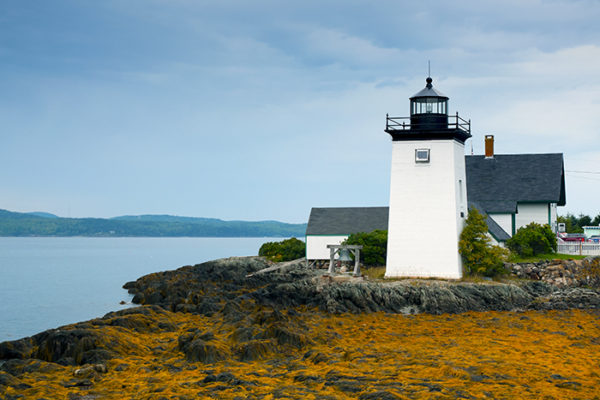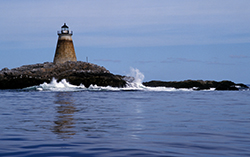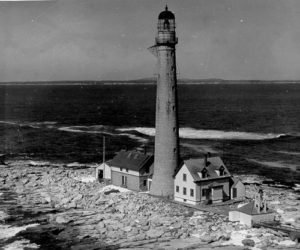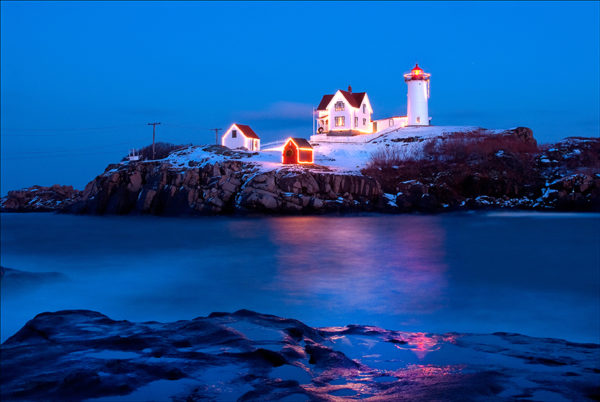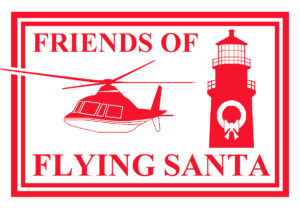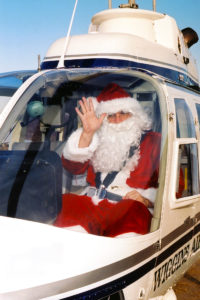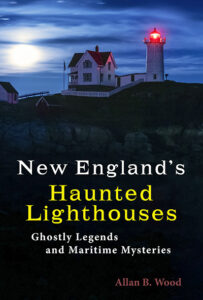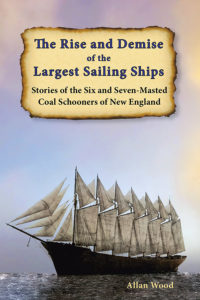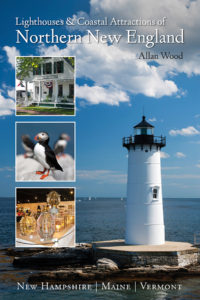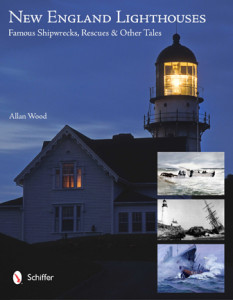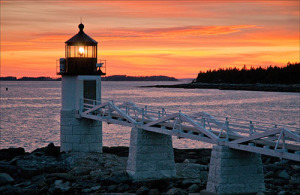Lighthouse Families Rescued By the Flying Santa(s) During the Holidays
Captain Wincapaw Thanks His Lighthouse Families
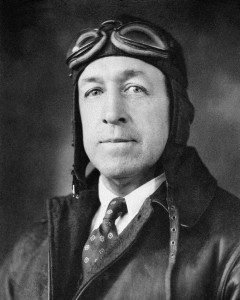
Captain William Wincapaw, the original “Flying Santa.” Photo courtesy Jeremy D’Entremont for the Wincapaw family.
The New England tradition of a “Flying Santa” delivering gifts to lonely and often isolated lighthouse keepers and their families started over 92 years ago in 1929, when a mid-coast Maine pilot, Captain William Wincapaw, started delivering gifts for his lighthouse keeper friends in Penobscot Bay, out of his hometown of Friendship, Maine. He was often directly involved in saving islanders’ lives along Penobscot Bay. He would help transport those sick or injured to safety or nearby hospitals, even in inclement weather. He navigated the region using the lighthouse beacons along the coastline in those days. He always appreciated the lighthouse keepers’ dedication to maintaining the lights, as they appreciated the Captain for his rescue efforts. Wincapaw decided in 1929 that on Christmas morning, he would load up his plane with a dozen packages of newspapers, magazines, coffee, candy, and other small luxuries for his isolated lighthouse families and friends in the Rockland region of Maine and drop them off to show his appreciation of their heroism and efforts throughout the year. He wanted them to be remembered, especially during the lonely holiday season. Word got around rather quickly of this saintly gesture, and he was so surprised by the outpouring of thanks from the keepers and the locals that he decided to make it an annual tradition, increasing his range to additional stations all along the New England coast and beyond.
Lighthouse historian Edward Rowe Snow, who accompanied Wincapaw seven years later, also helped to deliver along additional routes years afterward, as the two became very close friends.
On July 16, 1947, as Captain Wincapaw was taking off from Rockland Harbor with a passenger, Robert Muckenhirn, he suffered a heart attack in the air, and the plane crashed in the ocean, killing both men. Many keepers, their families, islanders, and locals from all over New England attended his service in observance of their gratitude for his services. That December, Snow would drop a memorial wreath in Rockland Harbor in honor of his close friend.
Historian Edward Rowe Snow Carries on the Flying Santa Tradition for Nearly 44 Years
After the death of Captain Wincapaw, historian Edward Rowe Snow continued to carry on the now-famous tradition of delivering Christmas bundles to stations along the New England coast and expanded the delivery to 176 lighthouses in 1947. Over the years, during many of the flights, he would still hire a pilot out of his pay, and he and his wife would enjoy the satisfaction of their efforts as repayment. Their daughter would accompany them on their flights as part of the family tradition. Wiggins Airways also helped provide planes, and later helicopters, and occasionally offered pilots to support the Snows. On a few excursions, the Coast Guard would provide Snow with one of their aircraft to help him with his expanding deliveries. Packages would continue to be provided by the many sponsors. Snow continued to write books about New England stories and lighthouses, which he would also provide for the keepers and their families.
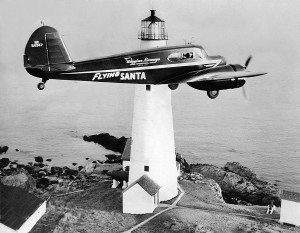
Snow flying over Boston Lighthouse (1947. Photo courtesy Jeremy D’Entremont for Dolly Snow Bicknell.
As there were rare occasions of a risk of a package missing its target and destroying property, Snow still had to carry rather expensive insurance for his endeavors. Although the 15-25 pound packages would usually land on their target, there were some instances where some property was destroyed, and the insurance would cover the mishap, with most of the “victims” recalling the experience to their families in a humorous manner. On many flights, as he would open the window to drop the gifts in his Santa costume, his fake whiskers would be blown off his face with the fierce winds. During one of his drops, they were scared when two packages tied to a rope lodged around the airplane’s tail near Boon Island Lighthouse in York, Maine. They could safely make an emergency landing at nearby Portsmouth, New Hampshire.
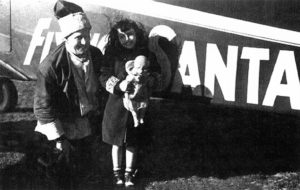
Edward Snow with Seaborn Ponsart presenting a gift. Photo courtesy Jeremy D’Entremont for Dolly Snow Bicknell
Snow used a helicopter to deliver the bundles in the 1940s and attempted to drop a bundle to Keeper Octave Ponsart’s family at West Chop Lighthouse on Martha’s Vineyard in Massachusetts. One of these gifts was a doll for his daughter Seaborn. Unfortunately, the doll broke inside the dropped bundle, and the little girl was heartbroken. However, upon hearing of the incident, Snow repurchased a new doll and personally delivered it to her.
In 1953, Snow decided to fly not only to New England stations but also to stations in California and Oregon. In 1954, he expanded his flights to include Bermuda, the Great Lakes, and a remote location known as Sable Island, about 100 miles from Nova Scotia. He arrived near the destination by seaplane and then took a horse-drawn wagon to the lighthouse, where he presented gifts to 3 children and 23 grateful adults on the tiny remote island.
In the 1970s, Snow also chartered boats to help with his tasks. In 1974, with much inclement weather, only some gifts could be distributed, and many trips had to be canceled, as many airports were snowbound. This hadn’t happened since the war era of the 1940s. During the 1970s, air space was restricted due to increasing FAA regulations. Snow found himself again using a helicopter to deliver the bundles, as he had done once many years before in 1946 to deliver an unbroken doll to Keeper Octave Ponsart’s daughter, Seaborn Ponsart, on Martha’s Vineyard. The children and their families enjoyed the new spectacle as the helicopter often came close or could land nearby.
By 1981, Snow was getting along in years and suffered a stroke, preventing him from dropping off any bundles that year. Judeth Van Hamm, director of the Hull Lifesaving Museum, approached Snow’s wife to offer any assistance. With the blessing of his wife, Ana-Myrle Snow, and with a limited budget and time to coordinate the undertaking, the museum was able to acquire the service of three helicopters from a local Boston television station, Wheelabrator-Frye of Maine, and the International Fund of Animal Welfare of Yarmouthport, Massachusetts. A new Santa, Ed McCabe, offered his services to continue the tradition. Although the number of flights was limited compared to previous years, and as many lighthouses were automated, it was greatly appreciated by those lucky recipients of the gifts.
On April 12, 1982, Snow passed away at 79. He had written over 90 books on maritime history, from shipwrecks to pirates to lighthouse stories, and remained one of the Flying Santas for nearly 44 years. He is also remembered as the driving force in saving Fort Warren, a famous Civil War fort on George’s Island in Boston Harbor, to be maintained as a public park for all to enjoy and to remember the efforts of those veterans who fought in that war. In 2000, a granite marker was placed at the pavilion as a memorial to Snow for visitors to George’s Island. It reads “Author, Historian, and ‘Flying Santa’. His efforts and writings about New England’s history and folklore remain in the hearts of all touched by the limitless generosity of his fellow friends.
The “Flying Santa” Tradition Continues
The Hull Lifesaving Museum in Massachusetts answered the call and continued the tradition of the Flying Santas. As years passed, other good Samaritans would follow Snow’s path and become Flying Santas, helping to increase the number of flights. Although the stops would be brief, they would try to manage extra flights to other lighthouses when at all possible. More local and corporate sponsors would provide gifts for the children to help with the efforts. In the late 1980s, local Boston news station WCVB-TV 5 would help the museum by providing a helicopter and much-needed public exposure. It is still involved with the Flying Santa events in Massachusetts today.
By 1997, the Flying Santa program was transferred from the Hull Lifesaving Museum to a non-profit group of volunteers calling themselves the Friends of Flying Santa. This non-profit organization would help to ensure a stable financial future by keeping the program alive and developing the official red logo to help with fundraising efforts on clothing and novelty items. The program continues today as a gesture of appreciation to the dedicated Coast Guard crews and their families. Now flying by helicopter, Santa’s route includes over 30 stops from Maine to New York.
Their Website, www.flyingsanta.com, keeps the public informed of events and helps in their efforts to raise funds for this wonderful program. All money raised by this campaign goes directly to purchase gifts for the children. There are no paid staff or administrative fees. If you want to help or learn more about the organization or upcoming events year-round, visit the Friends of Flying Santa website.
Nowadays, it is an event where those chosen lighthouses are many of the same lighthouses Captain Wincapaw and Edward Snow had flown over to deliver gifts so many years ago. Many sponsors continue to donate gifts to help with continuing this annual tradition. Since 1996, Chief Warrant Officer David Waldrip, USCG, and Chief Warrant Officer Tom Guthlein, USCG, have become the current Flying Santas. Pilots who have helped with the flights for the flying Santas include Tom Clegg, Paul Ellis, Tony Liss, George Louzek, Art Godjikian, LaRay Todd, Leo Boucher, Greg Harville, and many others.
Today, the Flying Santa comes down in a helicopter, calls out the names of the children in attendance, and presents them with a little gift to continue the annual tradition. It’s an exciting experience enjoyed by adults and children alike. This annual event is promoted and scheduled to remind people of the many personnel who came before to tend the lights and for the Flying Santas that made the process a part of their lives to help the lighthouse and Coast Guard families needing Christmas cheer. The events are used today as a simple expression of gratitude for the work performed by the Coast Guard.
The year 2019 celebrated the 90th anniversary of this wonderful organization and the generosity of extraordinary people, remembering those who guided our lighthouses and those in need.
Have a wonderful and safe holiday season, and spread the gift of generosity.
Enjoy!
Allan Wood
Books to Explore
New England’s Haunted Lighthouses:
Ghostly Legends and Maritime Mysteries
Discover the mysteries of New England’s haunted lighthouses! Uncover ghostly tales of lingering keepers, victims of misfortune or local shipwrecks, lost souls, ghost ships, and more. Many of these accounts begin with actual historical events that later lead to unexplained incidents.
Immerse yourself in the tales associated with these iconic beacons!
The Rise and Demise of the Largest Sailing Ships:
Stories of the Six and Seven-Masted Coal Schooners of New England.
In the early 1900s, New England shipbuilders constructed the world’s largest sailing ships amid social and political reforms. These giants were the ten original six-masted coal schooners and one colossal seven-masted vessel, built to carry massive quantities of coal and building supplies and measured longer than a football field! This self-published book, balanced with plenty of color and vintage images, showcases the historical accounts that followed these mighty ships.
Available also from bookstores in paperback, hardcover, and as an eBook for all devices.

Book – Lighthouses and Coastal Attractions in Southern New England: Connecticut, Rhode Island, Massachusetts
Lighthouses and Coastal Attractions of Southern New England:
Connecticut, Rhode Island, and Massachusetts.
This 300-page book provides memorable human interest stories from each of the 92 lighthouses, like the story of Maria Bray at Thacher Island Twin Lights. You can explore plenty of indoor and outdoor coastal attractions, including whale-watching excursions, lighthouse tours, windjammer sailing tours, parks, museums, and even lighthouses where you can stay overnight. You’ll also find plenty of stories of hauntings around lighthouses.
Lighthouses and Coastal Attractions of Northern New England:
New Hampshire, Maine, and Vermont.
This 300-page book provides memorable human interest stories from each of the 76 lighthouses, including the one about the Flying Santas. It also describes and provides contact info for plenty of indoor and outdoor coastal attractions and tours. These include whale watching, lighthouse tours, unique parks, museums, and lighthouses where you can stay overnight. There are also stories of haunted lighthouses in these regions.
New England Lighthouses:
Famous Shipwrecks, Rescues & Other Tales
This book has many stories, including the story of the Flying Santas. This image-rich book also contains vintage images provided by the Coast Guard and various organizations and paintings by six famous Coast Guard artists.
You can purchase this book and the lighthouse tourism books from the publisher Schiffer Books or in many fine bookstores such as Barnes and Noble.
Join, Learn, and Support The American Lighthouse Foundation
Copyright © Allan Wood Photography; do not reproduce without permission. All rights reserved.
